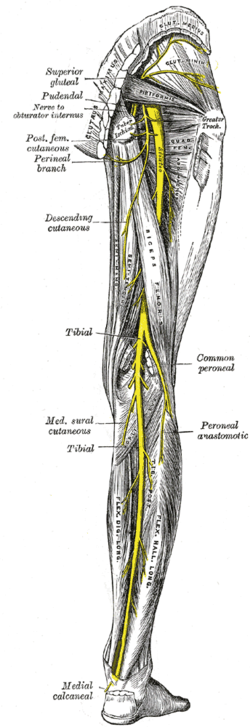Common peroneus nerve palsy
The N. peroneus receives fibers from the L4–S1 roots. From the n. ischiadicus it separates as a common trunk n. peroneus communis and in the area of penetration into the m. peroneus it is divided into a superficial and a deep branch. During its course, it encircles the head of the fibula, where it is placed very superficially and is often injured in this place.
It sensibly innervates the outer side of the calf. It motorically controls the eversion of the leg, the extensors of the front of the lower leg and the small muscles of the dorsum of the leg.
Image of polio[edit | edit source]
- Impairment of the extensors (dorsal flexion of the leg) and peroneal muscles (pronation of the foot), the patient cannot raise the toe, stand on the heel - walking is characteristic - from muscle paralysis the patient would drag the toe and the lateral edge of the leg on the mat and trip over them, so to compensate, to prevent this, he excessively bends the DK in the hip and knee - the so-called rooster walk (stork walk, peroneal walk), in addition, he taps - mats touches first with the toe and outer edge of the foot, then only with the heel
- Sensitivity disorders in the innervation area (mainly the back of the leg)
Causes[edit | edit source]
- Pressure in the area of the head fibula – the nerve can be pressed against the bone and bruised (eg: cast fixation, long-term immobilization, operative position on the side, long-term squatting position while working in the garden)
- Traction injury - result of knee dislocation or ankle distortion
- Strait syndrome - compression by a fibrous band in fibular tunnel, anterior tarsal tunnel syndrome
- Compartment Syndrome
- Systemic polyneuropathies - vasculitides, amyotrophic lateral sclerosis
Links[edit | edit source]
Related Articles[edit | edit source]
- Ischiadicus
- Fibula
- Tarsal Tunnel
- Fibular Tunnel
- Compartment Syndrome
- Vasculitides
- Amyotrophic lateral sclerosis
- Peripheral nerve involvement syndromes
- Tibialis nerve palsy
Source[edit | edit source]
- PASTOR, Jan. Langenbeck's medical web page [online]. [cit. 2009]. <https://langenbeck.webs.com/>.
- AMBLER, Zdeněk – BEDNAŘÍK, Josef, et al. Klinická neurologie : část speciální. II. 1. edition. Triton, 2010. ISBN 978-80-7387-389-9.

